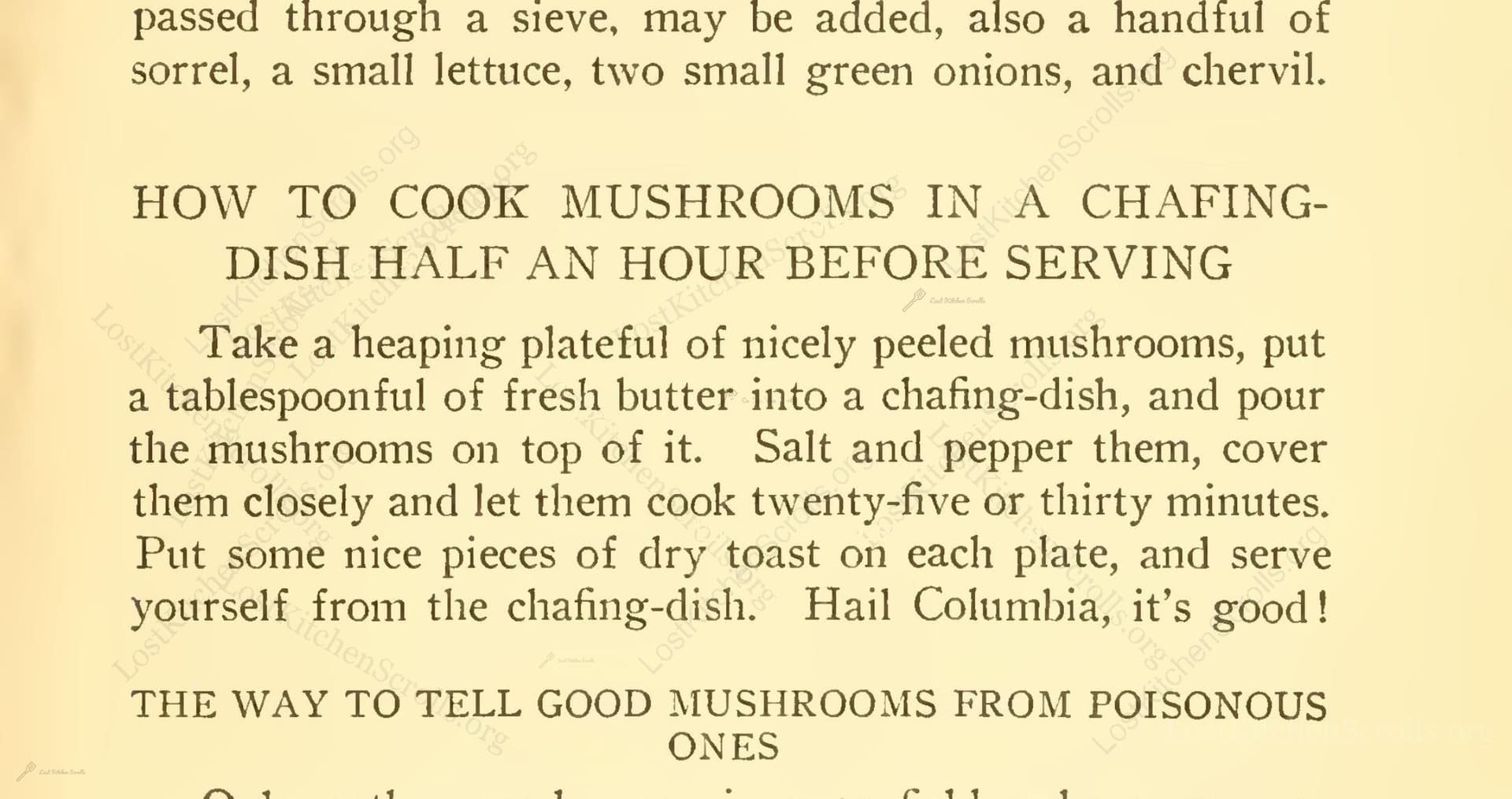
How To Cook Mushrooms In A Chafing- Dish Half An Hour Before Serving
"Take a heaping plateful of nicely peeled mushrooms, put a tablespoonful of fresh butterr into a chafing-dish, and pour the mushrooms on top of it. Salt and pepper them, cover them closely and let them cook twenty-five or thirty minutes. Put some nice pieces of dry toast on each plate, and serve yourself from the chafing-dish. Hail Columbia, it's good!"
Note on the Original Text
The recipe is written in a conversational, flowing style, with little in the way of strict instruction or measurements—common for early 20th-century cookbooks. Readers were assumed to have a working kitchen knowledge, and precise amounts were less important than feel and taste. Old spellings and phrasing—such as 'heaping plateful' or 'Hail Columbia, it's good!'—added color and local flavor to the recipes, making them as much a social document as a set of directions. The tone is enthusiastic, meant to entice the cook to try the dish and share it with friends.

Title
Cooking in old Créole days. La cuisine créole à l'usage des petits ménages (1903)
You can also click the book image above to peruse the original tome
Writer
Célestine Eustis
Era
1903
Publisher
R.H. Russell
Background
Take a delicious journey back in time with this charming bilingual collection of Creole and American recipes, crafted for cozy households. Célestine Eustis blends French flair with Southern soul, guiding both the novice and seasoned gourmand through the distinct flavors and delightful traditions of old Creole kitchens.
Kindly made available by
Internet Archive
This recipe hails from 'Cooking in old Créole days,' published in New York in 1903 by Célestine Eustis. The book captures the unique fusion of French, Spanish, African, and Native American influences that define Louisiana’s créole cuisine in the late 19th and early 20th centuries. Cooking in a chafing dish was all the rage for genteel entertaining at the turn of the century—a kind of tableside magic that allowed hosts to keep food warm and guests involved. This mushroom dish is typical of its era: simple ingredients, gently prepared, with an emphasis on robust flavor and engaging presentation.

The original would have been prepared in a chafing dish, a portable table-top pan with a heat source below—most often fueled by alcohol burners. This enabled cooks and hosts alike to assemble and finish dishes right at the dining table, adding a bit of theater to the meal. Other tools used would have included a small knife for peeling mushrooms, a plate for serving, and a cover to trap in the steam during cooking.
Prep Time
10 mins
Cook Time
30 mins
Servings
2
We've done our best to adapt this historical recipe for modern kitchens, but some details may still need refinement. We warmly welcome feedback from fellow cooks and culinary historians — your insights support the entire community!
Ingredients
- 14 ounces fresh mushrooms (button or cremini recommended)
- 1 tablespoon (0.5 ounce) unsalted butter
- 1/2 teaspoon salt
- 1/4 teaspoon ground black pepper
- Several slices of dry toasted bread
Instructions
- Start by cleaning and peeling about 14 ounces of fresh mushrooms—button or cremini work nicely as substitutes for wild varieties.
- In a wide skillet or saucepan (or a modern chafing dish, if you have one), melt 1 tablespoon (0.5 ounce) of unsalted butter over low to medium heat.
- Add the mushrooms and stir gently, seasonning with about 1/2 teaspoon of salt and 1/4 teaspoon of freshly ground black pepper.
- Cover tightly with a lid and allow the mushrooms to cook slowly for 25 to 30 minutes, stirring once or twise.
- Meanwhile, toast several slices of good-quality bread until crisp and dry.
- To serve, arrange the toasted bread on plates and spoon the buttery, succulent mushrooms over top.
- Serve immediately to capture the dish's warmth and aroma.
Estimated Calories
110 per serving
Cooking Estimates
It takes about 10 minutes to clean and prepare the mushrooms and toast the bread. Cooking the mushrooms takes around 30 minutes. Each serving has about 110 calories, and this recipe makes 2 servings.
As noted above, we have made our best effort to translate and adapt this historical recipe for modern kitchens, taking into account ingredients nowadays, cooking techniques, measurements, and so on. However, historical recipes often contain assumptions that require interpretation.
We'd love for anyone to help improve these adaptations. Community contributions are highly welcome. If you have suggestions, corrections, or cooking tips based on your experience with this recipe, please share them below.
Join the Discussion
Rate This Recipe
Dietary Preference
Main Ingredients
Culinary Technique
Occasions

Den Bockfisch In Einer Fleisch Suppen Zu Kochen
This recipe hails from a German manuscript cookbook compiled in 1696, a time whe...

Die Grieß Nudlen Zumachen
This recipe comes from a rather mysterious manuscript cookbook, penned anonymous...

Ein Boudain
This recipe comes from an anonymous German-language manuscript cookbook from 169...

Ein Recht Guts Latwerg
This recipe hails from a late 17th-century German manuscript, a comprehensive co...
Browse our complete collection of time-honored recipes



